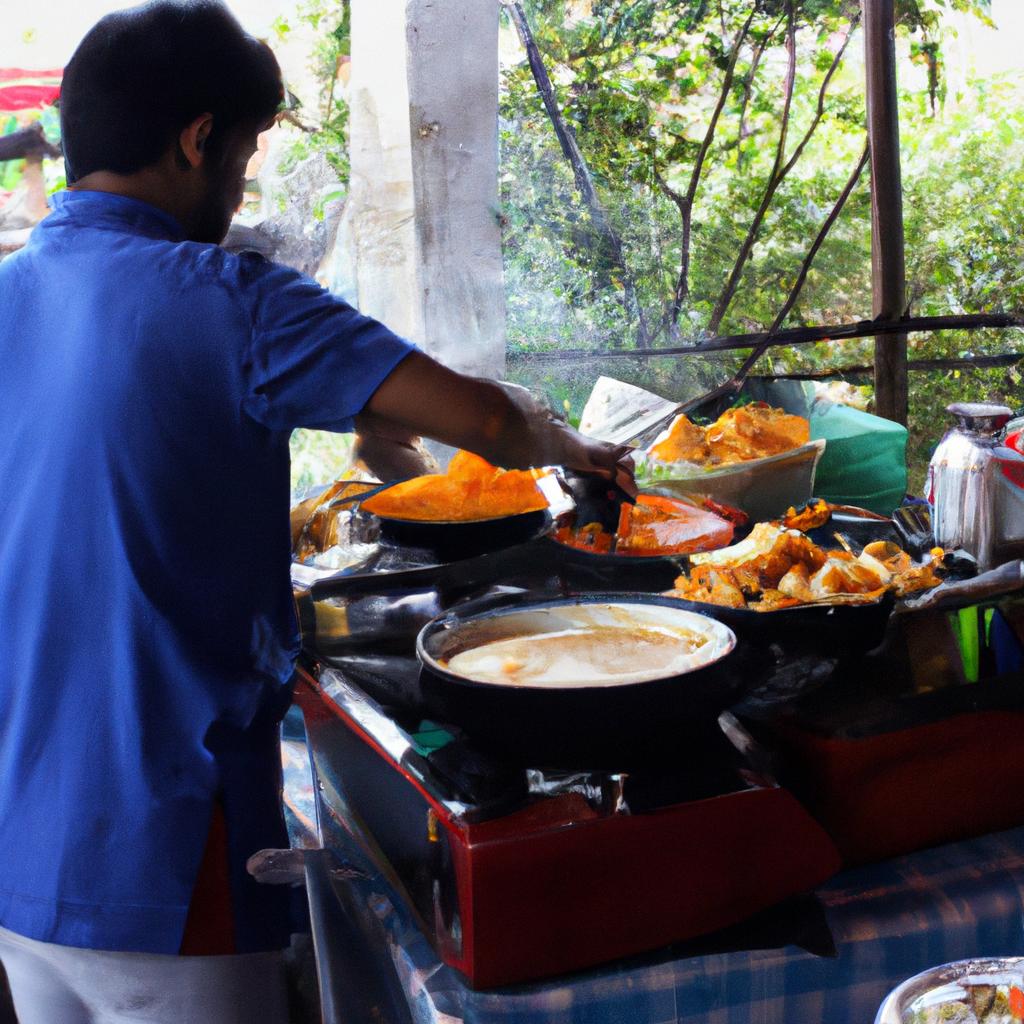Traditional street food markets have long been an integral part of local culinary culture in many regions around the world. These vibrant and bustling marketplaces offer a wide array of mouth-watering dishes that showcase the unique flavors and techniques of each respective destination. For instance, imagine strolling through the colorful streets of Bangkok, where the tantalizing aroma of freshly grilled satay fills the air as vendors skillfully prepare skewers of succulent marinated meat over open charcoal fires.
These traditional street food markets serve as gathering places for both locals and tourists alike, providing a sensory experience that goes beyond mere nourishment. The lively atmosphere, with its eclectic mix of sights, sounds, and smells, creates a sense of excitement and adventure for visitors. Moreover, these markets offer an opportunity to witness the rich cultural heritage of a place through its cuisine – from age-old family recipes passed down through generations to innovative fusion creations influenced by globalization. As such, they play a crucial role in preserving culinary traditions while simultaneously adapting to changing tastes and preferences.
In this article, we will delve into the fascinating world of traditional street food markets around the globe. We will explore their historical significance, examine how they contribute to local economies, and highlight some standout destinations renowned for their exceptional street food offerings . Additionally, we will discuss the impact of street food markets on tourism and provide tips for navigating these bustling culinary havens.
Traditional street food markets have a long and rich history, often tracing their roots back centuries. In many cultures, street food has been a staple of daily life, offering quick and affordable meals to people from all walks of life. These markets not only provide sustenance but also serve as social hubs where people gather to connect, share stories, and enjoy delicious food together.
From a socioeconomic perspective, traditional street food markets play a vital role in supporting local economies. They create employment opportunities for vendors, who are often small-scale entrepreneurs or family-owned businesses. The income generated from these markets helps to sustain livelihoods and contributes to the overall economic growth of the community.
Moreover, street food markets have become major tourist attractions in many cities and regions around the world. Travelers seek out these vibrant marketplaces as an authentic way to experience local culture and cuisine. The unique flavors and aromas found in street food dishes offer a true taste of a destination’s culinary identity.
Some standout destinations known for their exceptional street food offerings include Mexico City’s Mercado de San Juan, renowned for its diverse selection of tacos, tamales, and exotic meats; Marrakech’s Jemaa el-Fnaa Square in Morocco, where visitors can indulge in fragrant tagines and freshly squeezed orange juice; Penang’s hawker centers in Malaysia, famous for their flavorful noodle dishes like char kway teow; Osaka’s Dotonbori district in Japan with its mouth-watering takoyaki (octopus balls) stalls; and Istanbul’s Grand Bazaar in Turkey, where one can savor kebabs and baklava while exploring the labyrinthine alleys.
When visiting a traditional street food market, it is essential to embrace the sensory overload while keeping some practical tips in mind. Firstly, it is advisable to follow the locals’ lead and choose stalls with a high turnover of customers, as this indicates freshness and popularity. Additionally, practicing good hygiene by washing hands before eating or using hand sanitizers can help avoid any health issues.
Exploring traditional street food markets is a delightful adventure that allows travelers to immerse themselves in the local culinary scene and experience the true essence of a destination’s culture. So, next time you find yourself in a new city or country, be sure to seek out these bustling marketplaces for an unforgettable gastronomic journey.
History of Street Food Markets
Traditional street food markets have a rich history that dates back centuries, offering locals and tourists alike a taste of authentic cuisine. These vibrant marketplaces not only provide an opportunity to savor delicious local delicacies but also serve as cultural hubs where people gather to socialize and immerse themselves in the unique flavors of a region.
One intriguing example is the bustling Jemaa el-Fnaa square in Marrakech, Morocco. Here, visitors are greeted by the enticing aroma of traditional Moroccan spices wafting through the air. The square comes alive with food stalls serving mouthwatering dishes such as tagine, couscous, and harira soup. This lively marketplace has been captivating both residents and travelers for centuries, providing a glimpse into the culinary traditions of North Africa.
The appeal of street food markets lies not only in their delectable offerings but also in the sense of community they foster. These markets often act as meeting points where individuals from different walks of life come together to share stories, laughter, and meals. There is something inherently charming about sitting shoulder-to-shoulder at communal tables or standing side-by-side while devouring scrumptious treats on-the-go. It creates an atmosphere that encourages connection and camaraderie among strangers who bond over their shared love for good food.
- The joy of discovering hidden gems tucked away between market stalls.
- Nostalgia evoked by childhood memories triggered by familiar scents and tastes.
- Excitement sparked by trying new ingredients or flavor combinations.
- A sense of belonging experienced when engaging with friendly vendors who passionately showcase their culinary creations.
Additionally, here is a table showcasing some popular street food markets around the world:
| Market | Location | Specialty Dish |
|---|---|---|
| Borough Market | London, UK | Fish and chips |
| Chatuchak Weekend Market | Bangkok, Thailand | Pad Thai |
| La Boqueria | Barcelona, Spain | Jamón ibérico |
| Tsukiji Fish Market | Tokyo, Japan | Sushi |
As one delves into the history of street food markets, it becomes evident that these vibrant marketplaces hold a significant place in the culinary traditions of various cultures. Their ability to bring people together through shared experiences and flavors is truly remarkable. In the subsequent section, we will explore some popular street food markets around the world, highlighting their unique offerings and cultural significance.
Popular Street Food Markets Around the World
Having explored the fascinating history of street food markets, we now turn our attention to some of the popular street food markets around the world. One such example is the vibrant Mercado de San Miguel in Madrid, Spain. This bustling market offers a wide array of traditional Spanish dishes and delicacies, attracting both locals and tourists alike.
Paragraph 1:
From Asia to Europe, Africa to South America, street food markets have become an integral part of local culinary traditions across the globe. These lively hubs showcase not only the diverse range of flavors but also reflect the cultural identity and heritage of their respective regions. Let us delve into a few key characteristics that make these traditional markets so captivating:
- Aromatic scents wafting through narrow alleyways, enticing visitors with tantalizing aromas.
- Colorful displays of fresh produce, spices, and ingredients that create a feast for the eyes.
- Bustling crowds offering a sense of energy and excitement as people gather to savor delicious fare.
- Interactions between vendors and customers fostering a convivial atmosphere where stories are shared and friendships are formed.
Table (markdown format):
| Characteristics | Examples |
|---|---|
| Aromatic Scents | Spicy curries in Bangkok |
| Sizzling kebabs in Istanbul | |
| Colorful Displays | Fresh fruit stalls in Rio de Janeiro |
| Vibrant spice bazaars in Marrakech | |
| Bustling Crowds | Night markets in Taipei |
| Fish markets in Tokyo | |
| Interactions | Haggling over prices at souks |
| Sharing recipes with local vendors |
Paragraph 2:
It is important to note that street food markets not only offer an opportunity to indulge in mouthwatering cuisine but also provide economic support to small-scale local vendors. These markets often serve as a platform for budding entrepreneurs and culinary artisans, allowing them to showcase their skills and creativity to a wider audience. By supporting these humble establishments, visitors not only contribute to the local economy but also help preserve traditional food cultures for future generations.
Paragraph 3:
As we continue our exploration of street food markets, it is essential to understand the etiquette that surrounds this vibrant culinary experience. In the upcoming section on ‘Street Food Market Etiquette,’ we will delve into the unspoken rules and customs that can enhance your enjoyment and ensure a harmonious interaction with both vendors and fellow patrons.
With an understanding of what makes street food markets so captivating, let us now explore the etiquettes one must keep in mind when experiencing these gastronomic delights firsthand.
Street Food Market Etiquette
As we delve further into the realm of street food, it is essential to explore the traditional street food markets that offer an authentic culinary experience. These bustling hubs of flavors and aromas provide a glimpse into local culture and gastronomy. To illustrate, let us consider the vibrant streets of Bangkok’s Yaowarat Road, where one can find countless stalls offering iconic Thai dishes such as Pad Thai and Tom Yum Goong.
Exploration through Senses:
Immersing oneself in a traditional street food market is akin to embarking on a sensory adventure. The sights, sounds, and smells merge harmoniously to create an atmosphere brimming with energy and excitement. Here are some elements that contribute to this multisensory experience:
- Aroma wafts through the air as sizzling skewers of marinated meat tempt passersby.
- Colorful displays of fresh produce catch the eye, showcasing vibrant fruits and vegetables unique to each region.
- Conversations blend together in a symphony of languages, illustrating the diverse backgrounds present at these markets.
- The hustle and bustle of eager customers creates a dynamic ambiance that heightens anticipation for delectable treats.
Table: Embrace the Vibrancy – Experiencing Traditional Street Food Markets
| Element | Description |
|---|---|
| Aromas | Mouthwatering scents fill the air, enticing visitors. |
| Colors | Diverse array of colorful ingredients captivate eyes. |
| Languages | Multilingual conversations showcase cultural diversity. |
| Ambiance | Lively atmosphere adds excitement to the dining experience. |
Historical Significance:
Beyond their contemporary appeal, traditional street food markets often hold deep historical significance. These culinary hubs have withstood the test of time, preserving age-old recipes and cooking techniques that have been passed down through generations. They serve as platforms for cultural exchange and provide opportunities to learn about a region’s heritage.
The exploration of traditional street food markets offers an immersive experience that extends beyond mere consumption. It allows individuals to connect with local customs, traditions, and flavors in a way that no other dining setting can replicate. As we move forward with our culinary journey, let us now delve into the must-try street food dishes found within these vibrant markets.
With an understanding of the sensory allure and historical importance of traditional street food markets established, it is time to explore the diverse range of mouthwatering delicacies awaiting eager travelers and locals alike. In the subsequent section on “Must-Try Street Food Dishes,” we will uncover some gastronomic gems worth seeking out during your next visit to these bustling havens of flavor.
Must-Try Street Food Dishes
Section: Exploring Street Food Markets
Imagine strolling through the bustling streets of a vibrant city, where the tantalizing aroma of sizzling street food fills the air. You find yourself irresistibly drawn to a lively street food market, enticed by the promise of mouthwatering local delicacies. In this section, we will delve into the world of traditional street food markets and discover their unique charm.
Street food markets are not just places to grab a quick bite; they offer an immersive cultural experience that allows you to connect with the heart and soul of a destination. These markets serve as platforms for local vendors to showcase their culinary prowess and preserve age-old recipes passed down through generations. For instance, in Bangkok’s famous Chatuchak Weekend Market, visitors can sample dishes like Pad Thai – stir-fried rice noodles with shrimp or chicken – prepared using authentic techniques that have remained unchanged over time.
To further highlight the captivating allure of street food markets, consider these emotions they evoke:
- Excitement: The joyful atmosphere created by bustling crowds, vivid colors, and enticing aromas stimulates your senses.
- Curiosity: Each stall holds its own mystery waiting to be unraveled as you explore diverse flavors and ingredients.
- Adventurousness: Trying unfamiliar tastes from different cultures encourages you to step out of your comfort zone.
- Nostalgia: Traditional street food evokes memories of childhood or past travels, invoking a sense of nostalgia.
Let us now take a closer look at some key elements that contribute to the enchantment of street food markets:
| Elements | Description |
|---|---|
| Diversity | Street food markets offer an array of cuisines representing various regions and ethnicities. From spicy Indian curries to savory Mexican tacos, there is something for every palate. |
| Authenticity | Unlike restaurants tailored towards tourists’ preferences, street food stalls often maintain authenticity by adhering to traditional recipes and cooking methods. |
| Community | Street food markets foster a sense of community, with vendors interacting closely with customers and creating a convivial atmosphere that transcends cultural boundaries. |
| Accessibility | These markets cater to all walks of life, providing affordable yet delectable options for locals and travelers alike. |
As we conclude this section on exploring street food markets, we embark upon the next step: understanding the sustainability practices adopted by these culinary delights havens. By examining their environmental impact and initiatives towards responsible dining, we can delve deeper into the realm of sustainable gastronomy.
[Transition] Now let us explore the concept of sustainability in relation to street food markets and how they are striving to create an eco-friendly future while preserving their rich gastronomic heritage.
Sustainability and Street Food Markets
Transitioning smoothly from the previous section about must-try street food dishes, it is evident that traditional street food markets hold significant cultural value. These bustling areas not only offer a wide variety of delectable treats but also serve as vibrant hubs where locals and tourists alike can experience the unique flavors and customs of a particular region.
To illustrate this point, let us consider the case study of Bangkok’s famous Chatuchak Weekend Market. With its maze-like layout and countless stalls offering an array of mouthwatering delicacies, this market has become emblematic of Thai street food culture. Here, visitors can savor popular dishes such as pad Thai, mango sticky rice, and tom yum soup while immersing themselves in the lively atmosphere created by enthusiastic vendors and curious onlookers.
The influence of traditional street food markets extends beyond just culinary experiences. They play a vital role in preserving local traditions, fostering social interactions, and promoting economic growth within communities. To further emphasize their significance, here are some key points to consider:
- Community Engagement: Street food markets provide opportunities for residents to connect with one another, strengthening communal bonds through shared meals and conversations.
- Cultural Exchange: These markets attract both locals and travelers from different backgrounds, facilitating cross-cultural interaction and mutual understanding.
- Economic Opportunities: By supporting small-scale vendors who often use locally sourced ingredients, these markets contribute to sustainable livelihoods and boost the local economy.
- Preservation of Culinary Heritage: Traditional recipes passed down through generations find a platform in street food markets; they help preserve indigenous cooking methods that might otherwise be lost over time.
Table: Impact Areas of Traditional Street Food Markets
| Impact Area | Description |
|---|---|
| Community Engagement | Provides opportunities for socializing and connecting |
| Cultural Exchange | Promotes intercultural understanding |
| Economic Opportunities | Supports local vendors and boosts the economy |
| Culinary Heritage | Preserves traditional recipes and cooking methods |
In conclusion, traditional street food markets serve as more than just venues to indulge in tantalizing dishes. They are vibrant cultural spaces that foster community engagement, encourage cross-cultural dialogue, create economic opportunities, and safeguard culinary heritage. As we delve into the future of street food markets, it becomes evident how these dynamic hubs will continue shaping gastronomic experiences while adapting to changing societal trends.
Looking ahead, let us explore the potential innovations and advancements that await the future of street food markets.
The Future of Street Food Markets
These vibrant and bustling marketplaces not only offer a diverse range of mouthwatering delicacies but also provide an opportunity for communities to connect with their cultural heritage through food. To further explore the significance of these markets, we will delve into their ability to create economic opportunities, foster social cohesion, and preserve culinary traditions.
One compelling example showcasing the economic impact of street food markets can be found in Bangkok’s famous Chatuchak Weekend Market. With over 15,000 stalls offering an array of delectable treats from pad Thai to mango sticky rice, this sprawling marketplace attracts both locals and tourists alike. The revenue generated by the vendors contributes significantly to the local economy, providing livelihoods for countless individuals who rely on this booming business. Furthermore, street food markets often serve as incubators for aspiring chefs and entrepreneurs who use these platforms as stepping stones towards establishing their own restaurants or catering services.
The role of street food markets extends beyond mere economic benefits; they also play a pivotal role in fostering social cohesion within communities. These vibrant spaces bring people together from various walks of life – whether it be families seeking a quick meal after work or friends gathering for an evening snack. Street food markets act as melting pots where individuals can interact and forge connections amidst shared appreciation for good food. This communal aspect is particularly crucial in urban environments where city dwellers may otherwise feel disconnected from one another.
To fully grasp the extent of cultural preservation facilitated by street food markets, let us consider three key factors:
- Traditional recipes passed down through generations find a platform to flourish.
- Indigenous ingredients indigenous are celebrated rather than forgotten.
- Culinary techniques unique to specific regions are honored and upheld.
- Authentic flavors that might otherwise disappear due to globalization are embraced.
| Factors | Examples | Impact |
|---|---|---|
| Traditional recipes | Dim sum in Hong Kong, Tacos in Mexico City | Preservation of culinary heritage |
| Indigenous ingredients | Durian in Southeast Asia, Ghee in India | Recognition and promotion of local produce |
| Culinary techniques | Sushi-making in Japan, Tandoori cooking | Transmission of traditional methods to future generations |
| Authentic flavors | Kimchi in South Korea, Curry in Thailand | Cultural identity preservation through taste sensations |
In conclusion, street food markets continue to be remarkable cultural arenas where economic opportunities thrive, social bonds are forged, and culinary traditions are preserved. As exemplified by the Chatuchak Weekend Market in Bangkok, these vibrant marketplaces contribute significantly to local economies while providing platforms for aspiring chefs and entrepreneurs. Moreover, they foster a sense of community by bringing people together from diverse backgrounds. By celebrating traditional recipes, indigenous ingredients, culinary techniques unique to specific regions, and authentic flavors that define cultures worldwide, street food markets play an invaluable role in preserving our shared gastronomic heritage.



